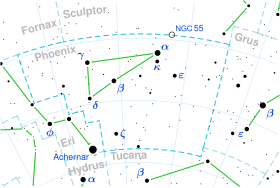Epsilon Phoenicis
Appearance
| Observation data Epoch J2000 Equinox J2000 | |
|---|---|
| Constellation | Phoenix |
| Right ascension | 00h 09m 24.64154s[1] |
| Declination | −45° 44′ 50.7315″[1] |
| Apparent magnitude (V) | 3.87[2] |
| Characteristics | |
| Spectral type | K0III[3] |
| U−B color index | +0.84[2] |
| B−V color index | +1.02[2] |
| Astrometry | |
| Radial velocity (Rv) | -9.20[4] km/s |
| Proper motion (μ) | RA: +121.52[1] mas/yr Dec.: -179.83[1] mas/yr |
| Parallax (π) | 22.62 ± 0.45 mas[1] |
| Distance | 144 ± 3 ly (44.2 ± 0.9 pc) |
| Absolute magnitude (MV) | 0.65[5] |
| Details | |
| Luminosity | 67.21[5] L☉ |
| Temperature | 4,750[6] K |
| Metallicity [Fe/H] | +0.01[5] dex |
| Rotational velocity (v sin i) | < 1.5[7] km/s |
| Other designations | |
| Database references | |
| SIMBAD | data |
Epsilon Phoenicis is a star in the constellation Phoenix. Its apparent magnitude is 3.87.[2] Located around 144 light-years (44 pc) distant, it is an orange giant of spectral type K0III,[3] a star that has used up its core hydrogen and has expanded.
References
- ^ a b c d e Van Leeuwen, F. (2007). "Validation of the new Hipparcos reduction". Astronomy and Astrophysics. 474 (2): 653–664. arXiv:0708.1752. Bibcode:2007A&A...474..653V. doi:10.1051/0004-6361:20078357. S2CID 18759600. Vizier catalog entry
- ^ a b c d Ducati, J. R. (2002). "VizieR Online Data Catalog: Catalogue of Stellar Photometry in Johnson's 11-color system". CDS/ADC Collection of Electronic Catalogues. 2237. Bibcode:2002yCat.2237....0D.
- ^ a b Houk, N. (1978). Michigan catalogue of two-dimensional spectral types for the HD stars. Vol. 2. Dept. of Astronomy, University of Michigan. Bibcode:1978mcts.book.....H.
- ^ Gontcharov, G. A. (2006). "Pulkovo Compilation of Radial Velocities for 35 495 Hipparcos stars in a common system". Astronomy Letters. 32 (11): 759–771. arXiv:1606.08053. Bibcode:2006AstL...32..759G. doi:10.1134/S1063773706110065. S2CID 119231169.
- ^ a b c Anderson, E.; Francis, Ch. (2012). "XHIP: An extended hipparcos compilation". Astronomy Letters. 38 (5): 331. arXiv:1108.4971. Bibcode:2012AstL...38..331A. doi:10.1134/S1063773712050015. S2CID 119257644. Vizier catalog entry
- ^ Gontcharov, G. A. (2009). "Red giant clump in the Tycho-2 catalogue". Astronomy Letters. 34 (11): 785–796. arXiv:1607.00619. Bibcode:2008AstL...34..785G. doi:10.1134/S1063773708110078. S2CID 73524157. Vizier catalog entry
- ^ De Medeiros, J. R.; Alves, S.; Udry, S.; Andersen, J.; Nordström, B.; Mayor, M. (2014). "A catalog of rotational and radial velocities for evolved stars". Astronomy & Astrophysics. 561: A126. arXiv:1312.3474. Bibcode:2014A&A...561A.126D. doi:10.1051/0004-6361/201220762. S2CID 54046583. Vizier catalog entry

